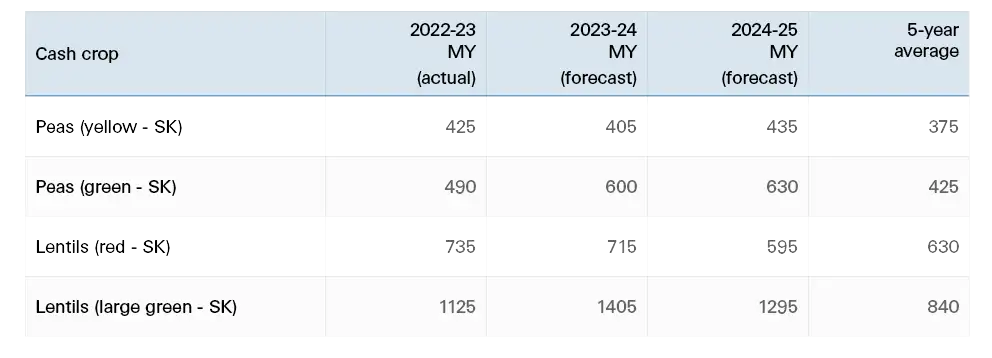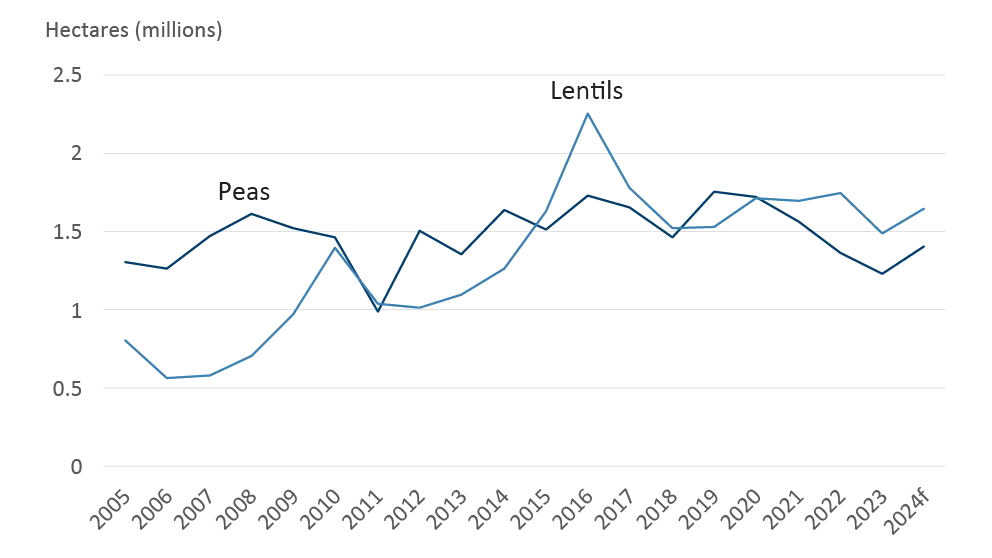2024 Pulses outlook: Looking good now, but it may be short-lived
Friday, March 1, 2024
Reference: FCC
 The North American outlook for pulses is good, with a market strength that, at the moment, exceeds that of many other major field crops. That support comes from strong export demand and the dry weather outlook.
The North American outlook for pulses is good, with a market strength that, at the moment, exceeds that of many other major field crops. That support comes from strong export demand and the dry weather outlook. Price support comes from currently low supplies, weather pressures and strong demand
Yellow and green peas will benefit from strong global demand, each expected to rise YoY to easily exceed their respective five-year averages (Table 1). While yellow peas will benefit from India’s recent extension of its tariff suspension, green peas are doing well with slim global supplies. Prices should continue to be high until this year’s North American crop is harvested, with weather being the largest factor to monitor.
Red lentil prices are expected to fall year-over-year (YoY) in the new crop year, declining below their five-year average. India’s harvest in February and March will have a major influence on movement of these prices as will Australia’s large red lentil export program.
Continued strong demand and lower supplies will support large green lentils which will fall YoY from their historic highs in the 2023/24 marketing year (MY) but remain well above their five-year average. The new crop supplies, boosted by increases in seeded acres and yields, are expected to align the supply/demand balance more closely with historical trends.
Table 1: Prices of lentils and peas going in opposite directions

Sources: Statistics Canada and FCC calculations
Marketing Year for peas and lentils: August 1 – July 31
Healthy, stable pulse export markets are critical to the prices received by Canadian producers. They determine the relative prices for green vs. red lentils and yellow vs. green peas with regional Asian differences in preferences for each type of pulse. Given that 74% of pea production and 81% of lentil production in Canada is exported, levels that are much higher than those for many grains and oilseeds, variations in these markets’ demand makes a difference.
Further, while Canada’s total exports of dried leguminous vegetables go to a diverse set of markets (with the top five markets accounting for 62% of total export values in 2023), exports of both lentils and peas are each more concentrated. Roughly 60% of lentil exports went to three countries - India 32.5%, Turkey 19.3% and United Arab Emirates at 8.4% - in 2023. Three quarters of pea markets are concentrated among three countries: China 55.8%, U.S. 11%, and Bangladesh 8.6%. Any disruption in those markets, whether supply or demand related, can entail significant variations in Canadian prices and exports.
Canadian lentil and pea acres to increase in 2024
With prices soaring for green lentils and peas, FCC Economics’ forecast of producers’ seeding intentions shows a YoY increase this year (Figure 1).Figure 1: Seeded acres expected to increase in response to price signals

Sources: Statistics Canada and FCC calculations
A possible negative development for prices: Pulses are better than many other field crops at handling dry weather and the anticipation of dry growing conditions in an El Nino summer may increase the acres devoted to pulses for 2024/25. More seeding will be challenged by tightening seed availability, however.
Accordingly, AAFC forecasts Canadian lentil production to rise significantly in the 2024/25 crop year (32%), with growth in total supply and carry-out stocks. That will, in turn, boost exports this year after the available Canadian supply was depleted in 2023/24 by a drought-impacted drop in production. The stocks-to-use ratio is forecast to more than double with the new crop.
Production of dry peas is forecast to grow 18.8% YoY after poor growing conditions reduced the 2023/24 MY crop 28% YoY. Both total supply and carryout stocks will grow enough to pressure prices of the new crop.
Trends to monitor
India’s continued suspension of tariffs on yellow peas in an era of production self-sufficiency: On February 21, India announced an extended suspension of pea tariffs by six to eight weeks beyond March 31st. The added demand has boosted prices at least temporarily. In the broader context however, it’s uncertain how long the suspension will last, although the stickiness of India’s elevated food inflation bodes well for yet another extension.India – the world's largest producer, importer and consumer of pulses – is boosting production in efforts to become as self-sufficient as possible. The recent Global Pulses Conference took note of the country’s self-reliance in chickpeas and many other pulses crops. Pulse production has grown by 60% from 17.1 million tonnes in 2014 to 27.0 million tonnes in 2024. That could challenge Canadian producers who’ve received higher Indian pea and lentil prices lately. India was Canada’s second-largest export market for pulses (behind China) over the last five years, accounting for 17.3% of Canadian export values. The Indian election this year could easily dictate changes in tariffs, policy and production incentives.
The development of China as an important export market has helped bridge the gap in exports to India whose demand has fluctuated due to weather-related domestic production constraints and the imposition of import tariffs. Going forward, Canada will vie with Russia and other pulse producers to build trade relations there.
Australian pulse production and pricing: Australia is projecting 1.39 million tonnes for its 2023-24 lentil crop production, slightly below the record-breaking 1.69 million in 2022/23. It has boosted exports of red lentils to global markets recently.
Shipping constraints in the Middle East: The war in Gaza has reignited delay issues and increased costs for cargo diversions around the Red Sea, where pulse shipments are carried by container.
An El Nino summer: Pulses can tolerate dry growing conditions better than other crops, but drought again this year would reduce yields for the second year in a row. There still seems to be price support for lentils and peas based on this possibility, but that could evaporate with good moisture levels.
Read More
Sign up to stay connected
- News
- Property Alerts
- Save your favourite properties
- And more!
Joining Farm Marketer is free, easy and you can opt out at any time.
